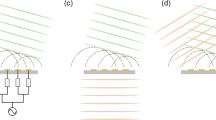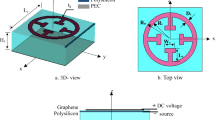Abstract
Magneto-optical devices based on Bragg diffraction of light by magnetostatic waves (MSWs) offer the potential of large time-bandwidth optical signal processing at microwave frequencies of 1 to 20 GHz and higher. A thin-film integrated-optical configuration, with the interacting MSW and guided-optical wave both propagating in a common ferrite layer, is necessary to avoid shape-factor demagnetization effects. The underlying theory of the MSW-optical interaction is outlined, including the development of expressions for optical diffraction efficiency as a function of MSW power and frequency, device geometry, materials properties, and other relevant parameters. Recent experimental observations of anisotropic Bragg diffraction and collinear TE↔TM mode conversion induced by MSWs in yttrium iron garnet (YIG) thin films suggest that high-performance MSW integrated-optical devices are feasible. Diffraction levels as large as 4% (7-mm interaction length) and a modulation dynamic range of ∼30 db have been demonstrated. Potential signal processing applications are mentioned, including: spectrum analyzers, convolvers/correlators, deflectors, non-reciprocal optical isolators, and tunable narrowband optical filters. Advantages of these MSW-based devices over the analogous acousto-optical devices include: much greater operating frequencies, tuning through the MSW dispersion relation by varying either the rf frequency or the applied bias magnetic field, simple MSW transducer structures (e.g., a single stripline), and the potential for very high diffraction efficiencies.
Similar content being viewed by others
References
M. Abe, M. Gomi, and S. Nomuma, “Magneto-optical properties of FeBO3 and YFeO3 their application to optical devices,”Ferrites: Proc of the ICF-3, p. 782 (Reidel, Boston, 1980).
J. D. Adam, T. W. O'Keefe, and M. R. Daniel, “Magnetostatic wave devices for microwave signal processing,” Proc. SPIE241, 96 (1980).
L. K. Anderson, “Observation of optical interaction with ferrimagnetic resonance,” Appl. Phys. Lett.1, 44 (1962).
B. A. Auld, “Magnetostatic and magnetoelastic wave propagation in solids,”Applied Solid State Science, Vol. 2, p. 2 (Academic, New York, 1971).
N. J. Berg and John N. Lee,Acousto-Optic Signal Processing Theory and Implementation (Marcel Dekker, New York, 1983).
I.C. Chang, “Tunable Acousto-optic filters, an overview,” Opt. Eng.16, 455 (1977).
D. Chen, “Magneto-optic materials,”Handbook of Lasers, R. J. Pressley, Ed. (CRC, Cleveland, 1971).
J. D. Cohen, “Incoherent-light time-integrating processors,”Acousto-optic Signal Processing Theory and Implementation, N. J. Berg and J. N. Lee, Eds. (Marcel Dekker, New York, 1983).
J. H. Collins and D. A. Wilson, “Optical probing of magnetostatic modes in YIG delay lines,” Appl. Phys. Lett.12, 331 (1968).
R. W. Damon and J. R. Eshbach, “Magnetostatic modes of a ferromagnet slab,” J. Phys. Chem. Solids.19, 308 (1961).
J. F. Dillon and J. P. Remeika, “Visual observations of magnetostatic modes,” Appl. Phys. Lett.2, 38 (1963).
R. W. Dixon, “Photoelastic properties of selected materials and their relevance for applications to acoustic light modulators and scanners,” J. Appl. Phys.38, 5149 (1967).
R. W. Dixon, “Acoustic diffraction of light in anisotropic crystals,” IEEE J. Quan. Elec.QE-3, 85 (1967).
G. Doriath, R. Gaudry, and P. Hartemann, “A sensitive and compact magnetometer using Faraday effect in YIG waveguides,” J. Appl. Phys.53, 8263 (1982).
P. R. Emtage, “Interactions of magnetostatic waves with a current,” J. Appl. Phys.49, 4475, (1978).
A. D. Fisher, J. N. Lee, E. S. Gaynor, and A. B. Tveten, “Optical guided-wave interactions with magneto-static waves at microwave frequencies,” Appl. Phys. Lett.41, 779 (1982).
A. D. Fisher, E. S. Gaynor, and J. N. Lee, “Magnetostatic wave devices for integrated-optical signal processing,” Proc. 1983 IEEE Ultrasonics Symp. (1983).
A. K. Ganguly and D. C. Webb, “Microstrip excitation of magnetostatic surface waves,” IEEE Trans. Microwave Th. and Tech.MTT-23, 998 (1975).
J. T. Hanlon and J. F. Dillon, “Microwave modulation of light in ferromagnetic resonance,” J. Appl. Phys.36, 1269 (1965).
P. Hansen, K. Witter, and W. Tolksdorf, “Magnetic and magneto-optic properties of lead-and bismuth-substituted yittrium iron garnet films,” Phys. Rev. B.27, 6608 (1983).
D. L. Hecht, “Acousto-Optic device techniques-400 to 2300 MHz,” Proc. 1977 IEEE Ultrasonics Symp. 721 (1977).
G. Hepner, J. P. Castera, and B. Desormiere, “Magnetic stripe domain deflector in integrated optics,” Appl. Opt.15, 1683 (1976).
H. L. Hu and F. R. Morganthaler, “Strong infrared-light scattering from coherent spin waves in YIG,” Appl. Phys. Lett.18, 307 (1971).
S. T. Kirsch, W. A. Biolsi, S. L. Blank, P. K. Tien, R. J. Martin, P. M. Bridenbaugh, and P. Grabbe, “Semileaky thin film optical isolator,” J. Appl. Phys.52, 3190 (1981).
D. E. Lacklison, G. B. Scott, H. I. Ralph, and J. L. Page, “Garnets with high magnetooptic figures of merit in the visible region,” IEEE Trans. on MagneticsMAG-9, 457 (1973).
L. D. Landau and E. M. Lifshitz,Electrodynamics of Continuous Media (Addison-Wesley, Reading, MA, 1960).
D. Mergerian and E. C. Malarkey, “Integrated optics,”Acousto-Optic Signal Processing Theory and Implementation, N. J. Berg and J. N. Lee, Eds. p. 373–453 (Marcel Dekker, New York, 1983).
J. M. Owens, L. Carter, C. V. Smith, and J. H. Collins, “Magnetostatic waves, microwave SAW?,” Proc. 1980 IEEE Ultrasonics Symp., 512 (1980).
S. F. Sauter, M. M. Hanson, and D. L. Fleming, “Multifunction integratedoptic device using magnetically alterable phase gratings,” Appl. Phys. Lett.30, 11 (1977).
A. Shibukawa and M. Kobayashi, “Optical TE-TM mode conversion in double epitaxial garnet waveguides,” Appl. Opt.20, 2444 (1981).
A. W. Smith, “Diffraction of light by magnetoelastic waves,” IEEE Trans. Sonics and UltrasonicsSU-15, 161 (1968).
G. A. Smolensky, A. N. Ageev, S. A. Mironov, and V. N. Greednev, “Optical phenoma in thin-film ferrite waveguides and their applications,”Ferrites: Proc of the ICF-3, (Reidel, Boston, 1980).
P. K. Tien, R. S. Martin, R. Wolfe, R. C. LeCraw, and S. L. Blank, “Switching and modulation of light in magneto-optic waveguides of garnet films,” Appl. Phys. Lett.21, 394 (1972).
C. S. Tsai, “Guided-wave acoustooptic Bragg modulators for wide-band integrated optic communications and signal processing,” IEEE Trans on Circuits and Systems,CAS-26, 1076 (1979).
C. Vittoria and N. D. Wilsey, “Magnetostatic wave propagation losses in an anisotropic insulator,” J. Appl. Phys.45, 414 (1974).
S. H. Wemple, J. F. Dillon, L. G. Van Uitert, and W. H. Grodkiewicz, “Iron garnet crystals for magneto-optic light modulators at 1.064μm,” Appl. Phys. Lett.22, 331 (1973).
D. L. Wood and J. P. Remeika, “Effect of impurities on the optical properties of yittrium iron garnet,” J. Appl. Phys.38, 1038 (1967).
A. Yariv, “Coupled mode theory for guided-wave optics,” IEEE J. Quan. Elec.QE-9, 919 (1973).
Author information
Authors and Affiliations
Rights and permissions
About this article
Cite this article
Fisher, A.D. Optical signal processing with magnetostatic waves. Circuits Systems and Signal Process 4, 265–284 (1985). https://doi.org/10.1007/BF01600085
Received:
Revised:
Issue Date:
DOI: https://doi.org/10.1007/BF01600085




